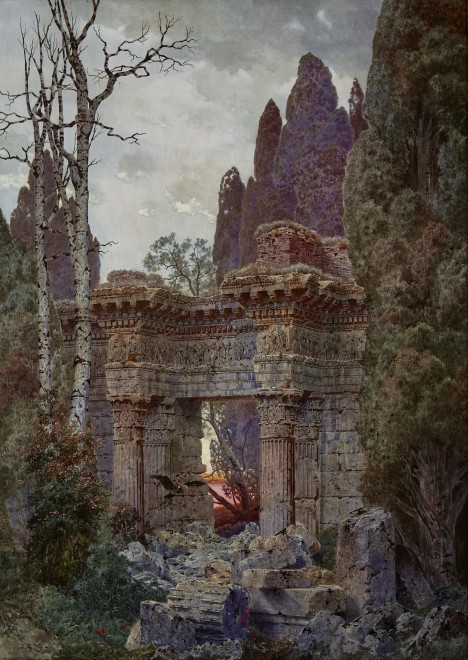Provenance
Private collection, Germany
Although sometimes called an “academic painter” Ferdinand Knab was actually a very poetic artist in the romantic vein who specialized in the depiction of ruins and architectural fragments. Born in Wurzberg, he initially trained in architecture in Nuremberg and then went to Munich in 1859 where his professors at the Academy were the well-established realistic masters of history painting, Arthur von Ramberg and Carl Theodor von Piloty. In 1860 his painting Patrician Court was exhibited by the Munich Art Association, and it was followed by several other successful showings. He was then able to gain a residency in Italy during 1868. It was this journey that revealed to Knab the scenic beauty of crumbling ruins set in picturesque landscapes. Like the great German writer Johann Wolfgang von Goethe, who visited Italy in 1786-88 and published his Italian Journey in 1816-17, Knab was enthralled by the wonders of Italian ruins, and his study of Roman antiquity took him, like Goethe, as far south as Taormina in Sicily. After his return to Germany, Knab drew on his memories to paint detailed treatments of ruins, real and imagined, set in scenic landscapes for the rest of his career. These subjects made Knab well known. King Ludwig II of Bavaria, famed as the patron of Wagner, named him a royal court painter and commissioned decorative works and plans for his Munich Residenz and the Linderhof Palace. Knab also produced set designs for a production of Mozart’s opera The Magic Flute in 1870. And in 1886 he created a series of color engravings devoted to recreations of the Seven Wonders of the Ancient World.
The taste for scenic Roman ruins in Italy and Greece had been established already in the eighteenth century by such visiting French artists as Hubert Robert, sometimes referred to as “Robert des Ruines,” whose work was extremely popular in Germany. A number of Robert’s drawings such as The Temple of Augustus at Pula, Archaeologists at the Temple of Vespasian, and even a Capriccio of the Portico of the Pantheon all with their elaborate Corinthian columns supporting a heavy pediment are certainly antecedents of Knab’s temple. The decorative artist Charles-Louis Clérisseau (1721-1820) also produced inventive depictions of Roman ruins. And of course the Italian printmaker Giovanni Battista Piranesi (1720-1778) had created many etchings of the picturesque ruins in Rome and its surroundings. These undoubtedly were known to Knab, as would have been period photographs of Italian ruins. There was, in fact, a tradition of earlier German artists of the nineteenth century, such as Karl Friedrich Schinkel and Leo von Klenze, being drawn to the subject of ancient classical ruins. The “quintessential” German Romantic painter of the nineteenth century, Caspar David Friedrich (1774-1840), never went to Italy, but he or his friend, Friedrich Carus, inspired undoubtedly by prints, painted a striking scene of the ruins at Agrigento. Friedrich also produced several romantic depictions of ruins and tombs at his favorite time of day – dusk. Later in the nineteenth century, Friedrich’s influence was especially strong on the Swiss-born painter Arnold Böcklin (1827-1901), who resided during the 1850s in Munich. He had absorbed classical elements from his time in Rome where he returned in the 1860s, but he was back in Munich in the 1870s, before finally settling in Italy. Böcklin often indulged in painting classical subjects or ruins in what have been described as subjects of “elegiac melancholy”, and the morbid mood of his most famous painting, The Island of the Dead, had a profound impact on his contemporaries. Like Knab’s painting, it shows a hermetic scene of carefully composed nature and buildings. From all of these diverse sources Knab crafted his own specialty of ruins in a romantic glowing light. Once having found his niche, he continued to produce variations on this theme for his entire career.
The impressive temple which is the centerpiece of this painting has not been identified, and is probably Knab’s own creation. In an inventive pastiche he combined massive Corinthian columns supporting a plinth with a frieze of sculpted figures. Perhaps, with his architectural skills, he actually constructed a model of this temple, so he could study it in the round. The artist, obviously fond of his creation, repeated it from different angles in several other compositions.
Knab’s work reveals his interest in transience and death. Scrutiny of Roman Ruins in Twilight indicates that the natural element may hold a hidden message. At the lower left, what appears to be a black stork takes flight. Like the mythical Phoenix, this large bird is commonly viewed as the symbol of transition, rebirth, and reincarnation. This bird’s presence amidst these crumbling ruins suggests the eternal conflict of life and death. In addition to the stork rising above the crumbling ruins, there is notale contrast between the bare birch tree, its twisted branches silhouetted against the sky at the left, and the flourishing cypress on the right. Along with the red poppies which dot the lower foreground, the cypress , through its association with cemeteries and mourning, is a clear symbol of death. Thus, this memorable landscape with its deteriorating ruings and declining light is fraught with emblems of transience and decay. Ferdinand Knab powerfully depicts a silent world of the past, with the setting sun casting a reflected glow on the ancient Roman structure. It is a haunting reverie, which reminds one of Goethe’s poetic description of the ruined Temple of Segesta in Sicily:
The site of the temple is remarkable…it towers over a vast landscape, and only a small corner of the sea is visible. The countryside broods in a melancholy fertility…The wind howled around the columns as though they were a forest, and birds of prey wheeled screaming above the empty shell.
